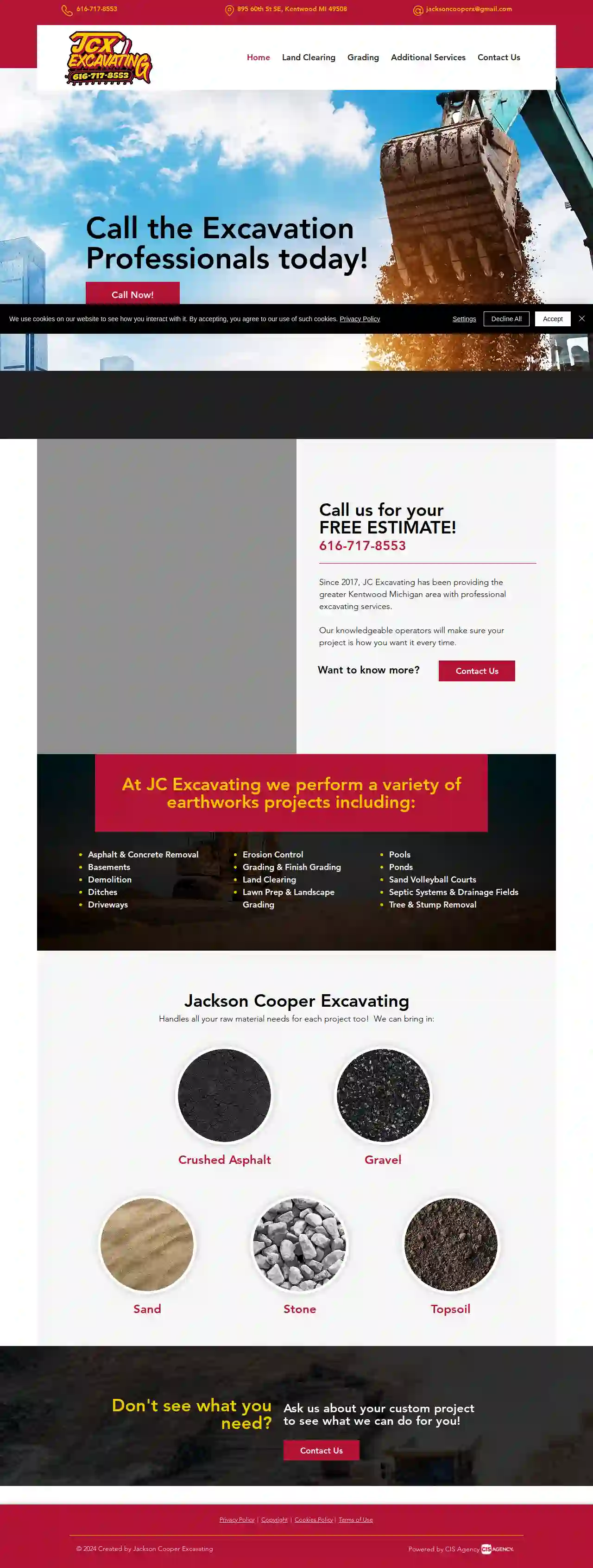Excavation Contractors Gladstone
Top 10 Excavation Companies in Gladstone
Get multiple Excavation Contractors quotes for your project today! Compare profiles, reviews, accreditations, portfolio, etc... and choose the best deal.

Premier Groundworks LLC
4.610 reviewsSouthfield, Michigan, USPremier Groundworks LLC Your trusted excavating contractor, hardscape installer, pond builder, and more! Call today to see what we can do for you. Serving all of Southeast Michigan. Premier Groundworks LLC offers beautiful commercial landscape design and other property maintenance and construction services throughout the Southeastern Michigan area. As a creative and professional commercial service, we handle build projects that include all aspects of industrial and commercial landscaping design, construction, plant installation, snow plowing, excavating and more. The commercial landscaping design experts at Premier Groundworks offer design and build services for many properties including: Residential community/Subdivision developments Parks and community centers Retail and office centers Health care facilities Religious organizations and institutions Municipalities Colleges and universities Small business complexes and many more. Commercial Excavating & Land Sculpting Premier Groundworks is a one-stop design-build company, specializing in sustainable and practical landscaping for commercial and residential projects. No matter the scope of excavating, or the property sculpting needs you require, Premier Groundworks can handle the task. We have the capabilities, experience, and creativity to exceed your expectations. Professional Commercial Landscaping Premier Groundworks plans and provides for successful completion of your commercial landscaping project through site analysis, budget proposals, and implementation. This is an essential key to a successful project.
- Services
- Why Us?
- Gallery
Get Quote
We Dig It Construction and Excavation
55 reviewsWarren, USAbout Us We Dig It is a full-service construction and excavation company located in South Jersey serving the needs of New Jersey, Delaware and Pennsylvania. We are a veteran-owned and operated business with over 15 years of experience in the industry. Our team is dedicated to providing our clients with the highest quality workmanship and customer service. We are committed to completing every project on time and within budget. We offer a wide range of services, including: Construction Landscaping Farming Land clearing Road construction Demolition Home renovation Excavation Residential Home and Garage Demolition Drainage Services Snow Removal Foundation Excavation Pool Removal We are proud to serve the communities of South Jersey, Delaware, and Pennsylvania. We are committed to providing our clients with the best possible experience. Contact us today for a free estimate.
- Services
- Why Us?
- Our Team
- Testimonials
- Gallery
Get Quote
Powell's Excavating & Septic, Inc
4.667 reviews20544 M-82, Howard City, 49329, USPowell's Excavating & Septic, Inc.: A Legacy of Service in West Michigan For over 50 years, the Powell family has been a trusted name in West Michigan, providing high-quality excavation and septic services. It all began in 1968 with Ken Powell and a single backhoe, laying the foundation for a business built on hard work, integrity, and a commitment to customer satisfaction. Ken's dedication to his craft and his family's values instilled a strong work ethic in his sons. As the business grew, his sons, Dave, Ken, and John, each played a vital role in its success. John, with his natural talent for management, took the reins in 1986, ensuring the continuation of the Powell legacy. Today, Powell's Excavating & Septic, Inc. remains a family-owned and operated business, upholding the same high standards and Christian values that have earned them a reputation for excellence. We are proud to serve our community, providing reliable and professional services for all your excavation and septic needs. Whether you're planning a new construction project, need a septic system installed, or require any other excavation services, our team is here to help. We are committed to delivering exceptional results, exceeding your expectations, and building lasting relationships with our clients.
- Services
- Why Us?
- Gallery
Get Quote
Jemco Excavating LLC
53 reviewsBranchburg, New Jersey, United States, USIndustry Leading Excavating Contractor Quality and Service Jemco Excavating is a family owned and operated excavating contractor with over 25 years of experience in the Central New Jersey area. We are committed to providing our clients with the highest quality service and workmanship. We will use our experience, knowledge and resources to find and implement the most effective strategies to complete your projects. Our services include: Site Preparation Drainage Underground Utility installation and repair Demolition Grading Land Clearing Trucking Driveway and Decorative Stone Retaining Walls Foundation Excavation Septic System repair and installation Sewer connection We are prompt and reliable, and our goal is to exceed your expectations on every project.
- Services
- Why Us?
- Gallery
Get Quote
Kalamazoo Excavation and Septic
5109 reviews2425 South 11th Street, STE. A, Kalamazoo, 49009, USFive-Star Excavation Services When it comes to excavation projects, choosing the right company is essential. It will determine whether your project is a success or failure — and mistakes can be costly for many years down the road. Kalamazoo Excavation’s crews are the best around, and they won’t stop until every job is done correctly, professionally, and to the highest industry standards. Our services include both commercial and residential: New construction Demolition Sewer and water — service installation or repair Septic systems — new or replacement Driveways and culverts Site clearing Barn and shed prep Grading and excavation We service all of southwest Michigan, including Allegan, Barry, Berrien, Branch, Cass, Eaton, Hillsdale, Kalamazoo, St. Joseph, and Van Buren counties. We work very closely with local developers and county health departments to ensure the correct scope and design of our projects. This ultimately protects homeowners by providing environmentally friendly and long-lasting solutions. Anyone who has worked with us knows — the only thing better than the quality of our work is the caliber of our people. They show up and get it done every day, anticipating and solving problems while treating our customers like friends and family. Our customers describe us as: Knowledgeable Punctual Dependable Honest Diligent Professional Responsive Friendly Courteous Attentive to detail Why Choose Kalamazoo Excavation? A Mission-Driven Excavation Team Our Mission Create the most productive excavation team in the WORLD through hard work, dedication, and commitment to excellence. We will innovate our industry while being a family-oriented team who achieves success by living our Core Values. Core Values Veteran — Here we value veterans and are thankful for our freedom. Appreciation — Here we lead with appreciation. Loyalty — Here we value loyalty. Unity — Here we unleash our personal strength through team unity. Efficiency — Here we seek maximum efficiency. Safety — Here we prioritize safety. Leave us a Google Review We value feedback and rely heavily on referrals. If you’ve had a positive experience with us, we’d love to hear about it. Your review helps us understand what we’re doing right and assists others in making informed decisions. Leave us a review! Hero Salute Giving The Kalamazoo Mortgage Hero Salute is a 501c3 founded to raise awareness for police, fire, and veteran-related issues. The nonprofit fills the short-term needs of veterans and first responders to help them get back on their feet and thank them for their service after life-altering experiences. Support veterans and first responders by making a gift today!
- Services
- Why Us?
- Gallery
Get Quote
Linsley Excavating Inc
59 reviews7610 Division Drive, Battle Creek, 49014, USWelcome to Linsley Excavating, Inc. We're a family owned company that's been around for over 45 years. We've worked in oilfields, subdivisions and commercial properties as well as subcontracting work. We service southwest Michigan. We're a family owned company that's been around for over 45 years. We've worked in oilfields, subdivisions and commercial properties as well as subcontracting work. We service southwest Michigan.
- Services
- Why Us?
- Gallery
Get Quote
Dirt World
4.232 reviews14370 Seaway Road, Gulfport, USAbout Us Since 2007 Dirt World has been the number one provider of soil, rocks, gravel, crushed concrete, crushed asphalt, wash out, sand and mulch. These items are sold by the cubic yard loaded on to your truck or trailer, or can be delivered by one of our trucks. All materials are available for pick up or delivery. We also offer installation and spreading of these material, and also offer a wide variety of land services including land clearing, bush hogging, excavator and bulldozer work, drive way repair and building, demolition and many other services.
- Services
- Why Us?
- Gallery
Get Quote
Jackson Cooper Excavating
51 reviews895 60th St SE, Kentwood, 49508, USCall the Excavation Professionals today! Since 2017, JC Excavating has been providing the greater Kentwood Michigan area with professional excavating services. Our knowledgeable operators will make sure your project is how you want it every time. Want to know more? Contact Us
- Services
- Why Us?
- Gallery
Get Quote
Eagle Excavation Inc
4.111 reviews4295 Holiday Drive, Flint, 48507, USEagle Excavation: Your Trusted Partner for Industrial & Commercial Earthwork Eagle Excavation is a full-service industrial and commercial excavating contractor with a strong commitment to quality. We've been serving mid to lower Michigan and surrounding states for over 30 years, building a reputation for excellence in diverse markets, including healthcare, research and development, public works, automotive, education, institutional, and municipal projects. Our skilled union workforce ensures every project is completed to the highest standards, exceeding your expectations. We take pride in our dedication to client satisfaction and delivering the best construction-related services for every project. At Eagle Excavation, we believe in doing it right the first time. Our experienced team, with over 30 years of combined experience, is dedicated to safety and efficiency. We're committed to providing a safe and healthy working environment for our employees and the communities we serve. We're always looking for talented individuals to join our team. If you're passionate about construction and share our commitment to quality, we encourage you to apply! Explore our gallery to see examples of our work and learn more about our services. We're confident that Eagle Excavation can be your trusted partner for your next construction and excavation project.
- Services
- Why Us?
- Our Team
- Gallery
Get Quote
Denny's Excavating Inc
53 reviewsGrand Rapids, USDenny's Excavating: Your Trusted West Michigan Excavation Partner Denny's Excavating has been serving West Michigan for over 25 years, providing reliable and professional excavation services for both residential and commercial clients. We're a family-owned and operated business with a strong commitment to quality, customer satisfaction, and safety. Our team is dedicated to delivering exceptional results on every project, no matter how big or small. We understand that excavation projects can be complex and require a high level of expertise. That's why we invest in the latest equipment and technology to ensure we can handle any job efficiently and effectively. Our team is also highly skilled and experienced, with a deep understanding of the local terrain and regulations. Whether you need a new driveway, a retaining wall, or a complete site preparation, Denny's Excavating is your one-stop shop for all your excavation needs. We offer a wide range of services, including: Driveways Retaining Walls Septic Systems Land Clearing French Drains General Contracting Erosion Control Manhole Services Storm Drains Parking Lot Maintenance Top Soil Delivery Sand Delivery Demolition Drainage Systems Land Development We're proud to serve the following communities in West Michigan: West Olive Grand Haven Holland Hudsonville Saugatuck / Douglas Zeeland Grand Rapids Contact us today for a free estimate and let us help you bring your next project to life.
- Services
- Why Us?
- Our Team
- Gallery
Get Quote
Over 22,076+ Excavation Companies onboarded
Our excavation contractors operate in Gladstone and beyond!
ExcavationHQ has curated and vetted the Best Excavation Contractors near Gladstone. Find a top & trustworthy business today.
Frequently Asked Questions About Excavation Contractors
- Determining Soil Suitability: Assessing whether the soil can support the intended structure or load.
- Recommending Foundation Types: Advising on the appropriate foundation design based on soil characteristics.
- Addressing Drainage and Erosion Issues: Providing solutions to manage water runoff and prevent erosion.
- Evaluating Slope Stability: Assessing the risk of landslides or soil movement on slopes.
- Building on challenging soil types (expansive clay, loose sand, etc.)
- Constructing large or complex structures
- Excavating near slopes or retaining walls
- Addressing drainage or erosion concerns
- Trench Collapses: Unstable trench walls can cave in, posing a severe risk to workers. Proper shoring and sloping are crucial safety measures.
- Utility Damage: Striking underground utilities (gas, water, electric) can cause leaks, explosions, or electrocution. Accurate utility locates and careful digging are essential.
- Falling Objects: Materials or equipment falling into excavations can injure workers. Securing work areas and using appropriate safety gear is vital.
- Equipment Accidents: Operating heavy machinery involves risks of rollovers, collisions, or mechanical failures. Trained operators and proper equipment maintenance are critical.
- Environmental Hazards: Excavated soil might contain hazardous materials (asbestos, lead). Proper testing and disposal procedures are necessary.
- Spring and Fall: Often considered favorable due to moderate temperatures and drier soil conditions.
- Summer: Can be suitable, but hot weather can make working conditions challenging and might require additional measures (shade, hydration) for workers.
- Winter: Excavation in winter can be more difficult due to frozen ground, snow, and potential delays caused by inclement weather. It might also require specialized equipment or techniques.
What is a soil engineer, and do I need one?
What are the risks associated with excavation?
What is the best time of year for excavation?
What is the difference between cut and fill excavation?
Cut: Involves excavating soil from an area where the existing grade is higher than the desired grade.
Fill: Refers to using the excavated soil ('cut' material) to raise the grade in an area where the existing grade is lower than desired.
This method minimizes the need to import or export soil, reducing costs and environmental impact. It's commonly used for site preparation, road construction, and landscaping.
What is a soil engineer, and do I need one?
- Determining Soil Suitability: Assessing whether the soil can support the intended structure or load.
- Recommending Foundation Types: Advising on the appropriate foundation design based on soil characteristics.
- Addressing Drainage and Erosion Issues: Providing solutions to manage water runoff and prevent erosion.
- Evaluating Slope Stability: Assessing the risk of landslides or soil movement on slopes.
- Building on challenging soil types (expansive clay, loose sand, etc.)
- Constructing large or complex structures
- Excavating near slopes or retaining walls
- Addressing drainage or erosion concerns
What are the risks associated with excavation?
- Trench Collapses: Unstable trench walls can cave in, posing a severe risk to workers. Proper shoring and sloping are crucial safety measures.
- Utility Damage: Striking underground utilities (gas, water, electric) can cause leaks, explosions, or electrocution. Accurate utility locates and careful digging are essential.
- Falling Objects: Materials or equipment falling into excavations can injure workers. Securing work areas and using appropriate safety gear is vital.
- Equipment Accidents: Operating heavy machinery involves risks of rollovers, collisions, or mechanical failures. Trained operators and proper equipment maintenance are critical.
- Environmental Hazards: Excavated soil might contain hazardous materials (asbestos, lead). Proper testing and disposal procedures are necessary.
What is the best time of year for excavation?
- Spring and Fall: Often considered favorable due to moderate temperatures and drier soil conditions.
- Summer: Can be suitable, but hot weather can make working conditions challenging and might require additional measures (shade, hydration) for workers.
- Winter: Excavation in winter can be more difficult due to frozen ground, snow, and potential delays caused by inclement weather. It might also require specialized equipment or techniques.
What is the difference between cut and fill excavation?
Cut: Involves excavating soil from an area where the existing grade is higher than the desired grade.
Fill: Refers to using the excavated soil ('cut' material) to raise the grade in an area where the existing grade is lower than desired.
This method minimizes the need to import or export soil, reducing costs and environmental impact. It's commonly used for site preparation, road construction, and landscaping.